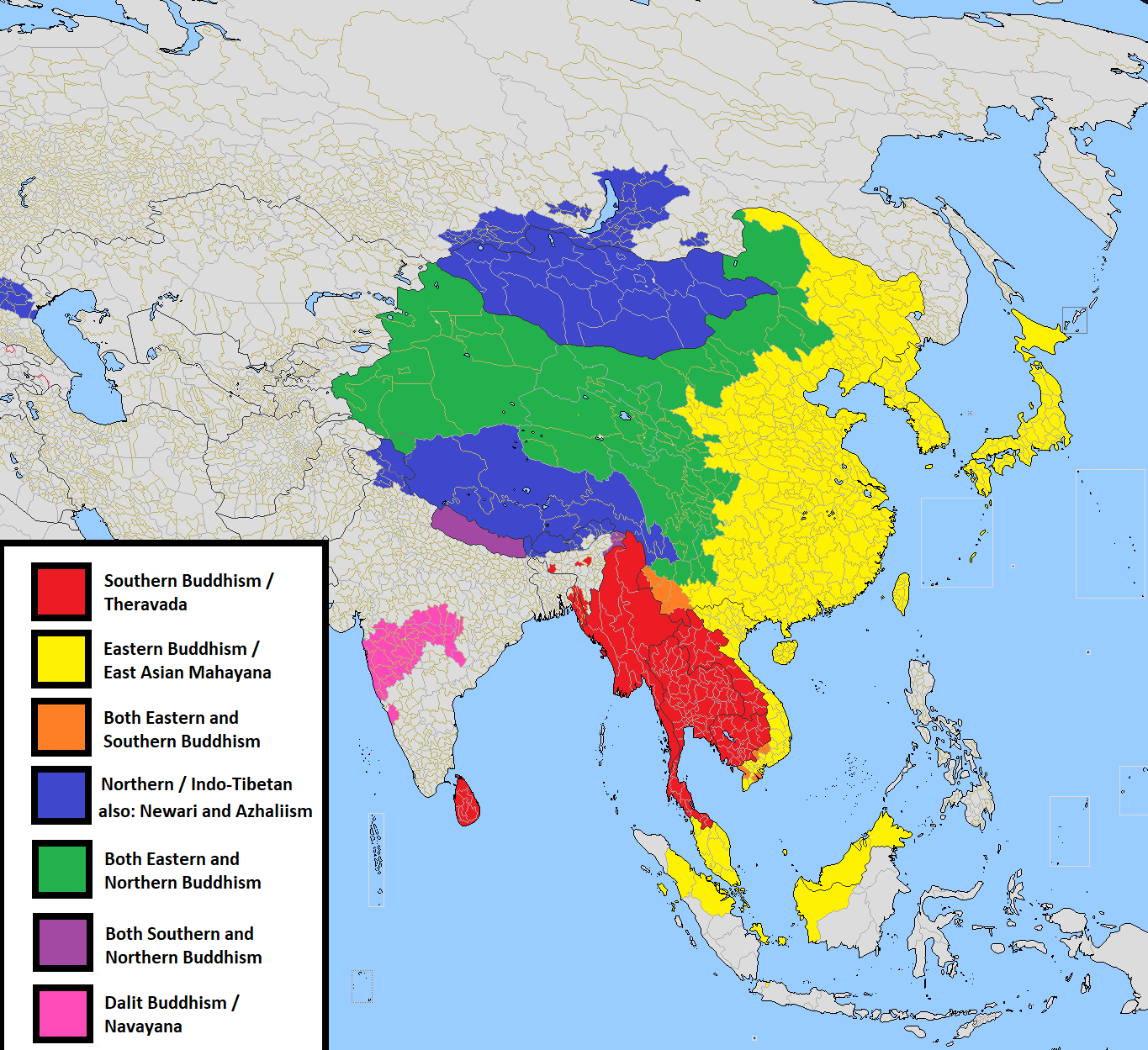|
Mettā Forest Monastery
Mettā Forest Monastery, also known as Wat Mettāvarānaṁ or Wat Mettā, is a Theravāda monastery in Valley Center, California. It was founded in 1991 by Ajaan Suwat Suvaco (1919–2002) along with his student Ṭhānissaro Bhikkhu. Ajaan Ṭhānissaro has been the resident abbot since 1993. Currently there are ten resident bhikkhus, nine American bhikkhus and one Thai, as well as space for lay Buddhists on overnight retreat. Ajaan Ṭhānissaro stresses the importance of strict adherence to the Vinaya or Buddhist monastic code which teaches relying only on donations from the lay community as well as living in the wilderness, a key feature of the Thai Forest Tradition of which he is a part. All visitors are expected to follow the Eight Precepts of Buddhism, which helps introduce students into the practice of Theravāda Buddhism. Historical Context Even though the Mettā Forest Monastery has not been widely studied, the founding of this monastery is of great importance i ... [...More Info...] [...Related Items...] OR: [Wikipedia] [Google] [Baidu] |
Thai Forest Tradition
The Kammaṭṭhāna Forest Tradition of Thailand (from pi, kammaṭṭhāna meaning Kammaṭṭhāna, "place of work"), commonly known in the West as the Thai Forest Tradition, is a Parampara, lineage of Theravada Buddhist monasticism. The Thai Forest Tradition started around 1900 with Ajahn Mun Bhuridatto, who wanted to practice Buddhist monasticism, and its meditative practices, according to the normative standards of pre-sectarian Buddhism. After studying with Ajahn Sao Kantasīlo and wandering through the north-east of Thailand, Ajahn Mun reportedly became a Anāgāmi, non-returner and started to teach in North-East Thailand. He strived for a revival of the Pre-sectarian Buddhism, Early Buddhism, insisting on a strict observance of the Buddhist monastic code, known as the Vinaya, and teaching the practice of ''jhāna'' and the realisation of ''nibbāna''. Initially, Ajahn Mun's teachings were met with fierce opposition, but in the 1930s his group was acknowledged as a f ... [...More Info...] [...Related Items...] OR: [Wikipedia] [Google] [Baidu] |
Buddhism In The United States
The term American Buddhism can be used to describe all Buddhist groups within the United States, including Asian Americans, Asian-American Buddhists born into the faith, who comprise the largest percentage of Buddhists in the country. American Buddhists come from every ethnicity, nationality and religious tradition. In 2012, ''U-T San Diego'' estimated U.S. practitioners at 1.2 million people, of whom 40% are living in Southern California. In terms of percentage, Hawaii has the most Buddhists at 8% of the population, due to its large Asian-American community. Statistics US States by Population of Buddhists Hawaii has the largest Buddhist population by percentage, amounting to 8% of the state's population. California follows Hawaii with 2%. Alaska, Arizona, Colorado, Connecticut, Illinois, Kansas, Louisiana, Maine, Maryland, Massachusetts, Michigan, Missouri, Montana, New Mexico, New York (state), New York, Ohio, South Dakota, Tennessee, Texas, Utah, Vermont, Virginia, Washington ... [...More Info...] [...Related Items...] OR: [Wikipedia] [Google] [Baidu] |
Buddhism In California
Buddhism ( , ), also known as Buddha Dharma and Dharmavinaya (), is an Indian religions, Indian religion or Indian philosophy#Buddhist philosophy, philosophical tradition based on Pre-sectarian Buddhism, teachings attributed to the Buddha. It originated in History of India, northern India as a -movement in the 5th century BCE, and Silk Road transmission of Buddhism, gradually spread throughout much of Asia via the Silk Road. It is the Major religious groups, world's fourth-largest religion, with over 520 million followers (Buddhists) who comprise seven percent of the global population. The Buddha taught the Middle Way, a path of spiritual development that avoids both extreme asceticism and hedonism. It aims at liberation from clinging and craving to things which are impermanent (), incapable of satisfying ('), and without a lasting essence (), ending the cycle of death and rebirth (). A summary of this path is expressed in the Noble Eightfold Path, a Bhavana, training of t ... [...More Info...] [...Related Items...] OR: [Wikipedia] [Google] [Baidu] |
Buddhist Monasteries In The United States
Buddhism ( , ), also known as Buddha Dharma and Dharmavinaya (), is an Indian religion or philosophical tradition based on teachings attributed to the Buddha. It originated in northern India as a -movement in the 5th century BCE, and gradually spread throughout much of Asia via the Silk Road. It is the world's fourth-largest religion, with over 520 million followers (Buddhists) who comprise seven percent of the global population. The Buddha taught the Middle Way, a path of spiritual development that avoids both extreme asceticism and hedonism. It aims at liberation from clinging and craving to things which are impermanent (), incapable of satisfying ('), and without a lasting essence (), ending the cycle of death and rebirth (). A summary of this path is expressed in the Noble Eightfold Path, a training of the mind with observance of Buddhist ethics and meditation. Other widely observed practices include: monasticism; "taking refuge" in the Buddha, the , and the ; and ... [...More Info...] [...Related Items...] OR: [Wikipedia] [Google] [Baidu] |
Buddhist Temples And Monasteries Of The Thai Forest Tradition
Buddhism ( , ), also known as Buddha Dharma and Dharmavinaya (), is an Indian religion or philosophical tradition based on teachings attributed to the Buddha. It originated in northern India as a -movement in the 5th century BCE, and gradually spread throughout much of Asia via the Silk Road. It is the world's fourth-largest religion, with over 520 million followers (Buddhists) who comprise seven percent of the global population. The Buddha taught the Middle Way, a path of spiritual development that avoids both extreme asceticism and hedonism. It aims at liberation from clinging and craving to things which are impermanent (), incapable of satisfying ('), and without a lasting essence (), ending the cycle of death and rebirth (). A summary of this path is expressed in the Noble Eightfold Path, a training of the mind with observance of Buddhist ethics and meditation. Other widely observed practices include: monasticism; " taking refuge" in the Buddha, the , and the ; and ... [...More Info...] [...Related Items...] OR: [Wikipedia] [Google] [Baidu] |
Buddhist Monasticism
Buddhist monasticism is one of the earliest surviving forms of organized monasticism and one of the fundamental institutions of Buddhism. Monks and nuns, called bhikkhu (Pali, Skt. bhikshu) and bhikkhuni (Skt. bhikshuni), are responsible for the preservation and dissemination of the Buddha's teaching and the guidance of Buddhist lay people. Three surviving traditions of monastic discipline ( Vinaya), govern modern monastic life in different regional traditions: Theravada (Sri Lanka and Southeast Asia), Dharmaguptaka (East Asia), and Mulasarvastivada (Tibet and the Himalayan region). History and development Buddhism originated as a renunciant tradition, practiced by ascetics who had departed from lay life. According to Buddhist tradition, the order of monks and nuns was founded by Gautama Buddha during his lifetime between the fifth and fourth centuries BCE when he accepted a group of fellow renunciants as his followers. The Buddhist monastic lifestyle grew out of the lif ... [...More Info...] [...Related Items...] OR: [Wikipedia] [Google] [Baidu] |
Theravāda Buddhism
''Theravāda'' () ( si, ථේරවාදය, my, ထေရဝါဒ, th, เถรวาท, km, ថេរវាទ, lo, ເຖຣະວາດ, pi, , ) is the most commonly accepted name of Buddhism's oldest existing school. The school's adherents, termed Theravādins, have preserved their version of Gautama Buddha's teaching or '' Buddha Dhamma'' in the Pāli Canon for over two millennia. The Pāli Canon is the most complete Buddhist canon surviving in a classical Indian language, Pāli, which serves as the school's sacred language and '' lingua franca''.Crosby, Kate (2013), ''Theravada Buddhism: Continuity, Diversity, and Identity'', p. 2. In contrast to ''Mahāyāna'' and ''Vajrayāna'', Theravāda tends to be conservative in matters of doctrine (''pariyatti'') and monastic discipline ('' vinaya''). One element of this conservatism is the fact that Theravāda rejects the authenticity of the Mahayana sutras (which appeared c. 1st century BCE onwards). Modern Theravā ... [...More Info...] [...Related Items...] OR: [Wikipedia] [Google] [Baidu] |
Schools Of Buddhism
The schools of Buddhism are the various institutional and doctrinal divisions of Buddhism that have existed from ancient times up to the present. The classification and nature of various doctrinal, philosophical or cultural facets of the schools of Buddhism is vague and has been interpreted in many different ways, often due to the sheer number (perhaps thousands) of different sects, subsects, movements, etc. that have made up or currently make up the whole of Buddhist traditions. The sectarian and conceptual divisions of Buddhist thought are part of the modern framework of Buddhist studies, as well as comparative religion in Asia. From a largely English-language standpoint, and to some extent in most of Western academia, Buddhism is separated into two groups: Theravāda, literally "the Teaching of the Elders" or "the Ancient Teaching," and Mahāyāna, literally the "Great Vehicle." The most common classification among scholars is threefold: Theravāda, Mahāyāna and Vajrayāna. ... [...More Info...] [...Related Items...] OR: [Wikipedia] [Google] [Baidu] |
Ajaan Suwat Suvaco
Ajaan Suwat Suvaco (27 August 19195 April 2002), born in Thailand, was a Buddhist monk who founded four monasteries in the western United States. Ordained at the age of twenty, he became a student of Ajaan Funn Acaro two or three years later. He also studied briefly with Ajaan Mun. Following Ajaan Funn's death in 1977, Ajaan Suwat stayed on at the monastery to supervise his teacher's royal funeral and the construction of a monument and museum in Ajaan Funn's honor. In the 1980s Ajaan Suwat came to the United States, where he established his four monasteries: one near Seattle, Washington; two near Los Angeles; and one in the hills of San Diego County (Metta Forest Monastery). He returned to Thailand in 1996, and died in Buriram on 5 April 2002, after a long illness. ( |
Vinaya
The Vinaya (Pali & Sanskrit: विनय) is the division of the Buddhist canon ('' Tripitaka'') containing the rules and procedures that govern the Buddhist Sangha (community of like-minded ''sramanas''). Three parallel Vinaya traditions remain in use by modern ''sanghas'': the Theravada (Sri Lanka & Southeast Asia), Mulasarvastivada (Tibetan Buddhism and the Himalayan region) and Dharmaguptaka (East Asian Buddhism). In addition to these Vinaya traditions, Vinaya texts of several extinct schools of Indian Buddhism are preserved in the Tibetan and East Asian canons, including those of the Kāśyapīya, the Mahāsāṃghika, the Mahīśāsaka, and the Sarvāstivāda The word ''Vinaya'' is derived from a Sanskrit verb that can mean to lead, take away, train, tame, or guide, or alternately to educate or teach. It is often translated as 'discipline', with ''Dhamma-vinaya'', 'doctrine and discipline', used by the Buddha to refer to his complete teachings, suggesting its integral ... [...More Info...] [...Related Items...] OR: [Wikipedia] [Google] [Baidu] |





